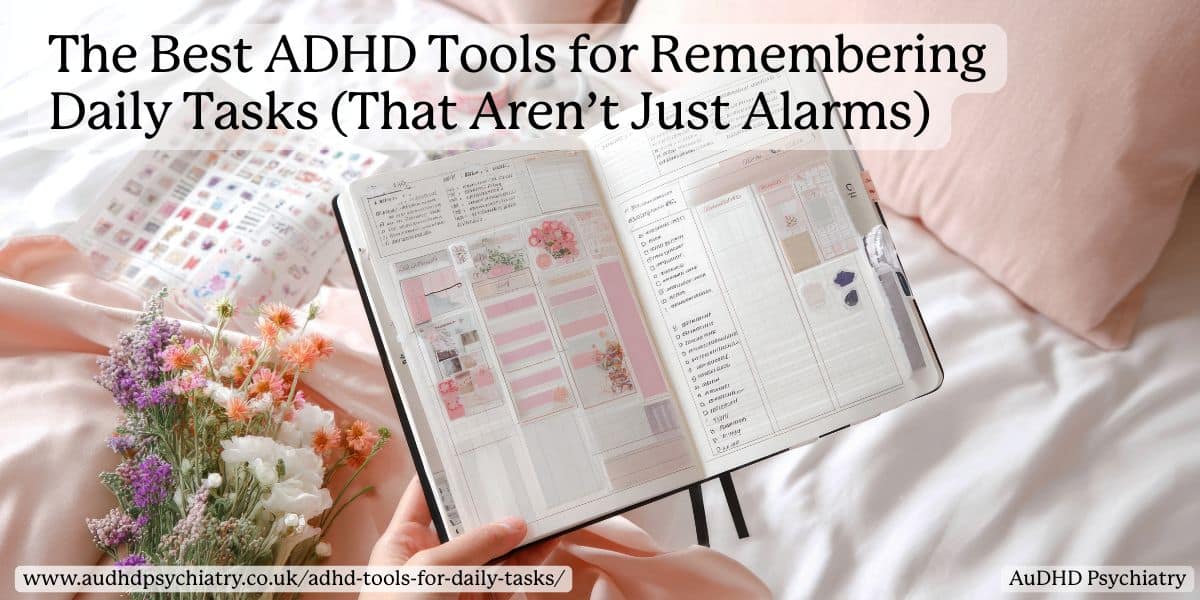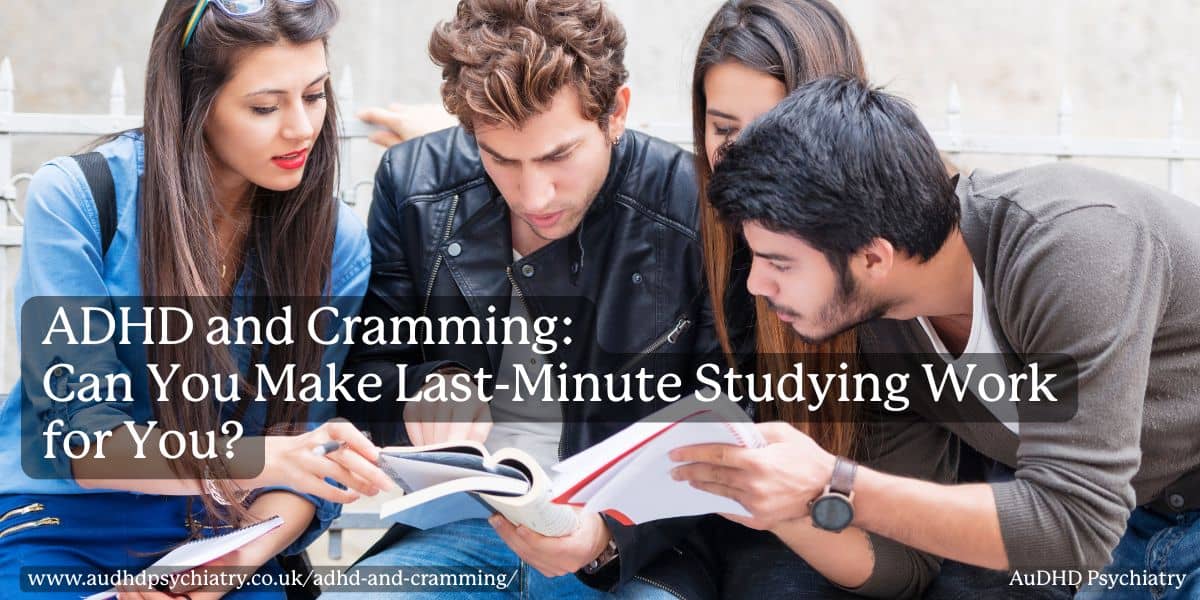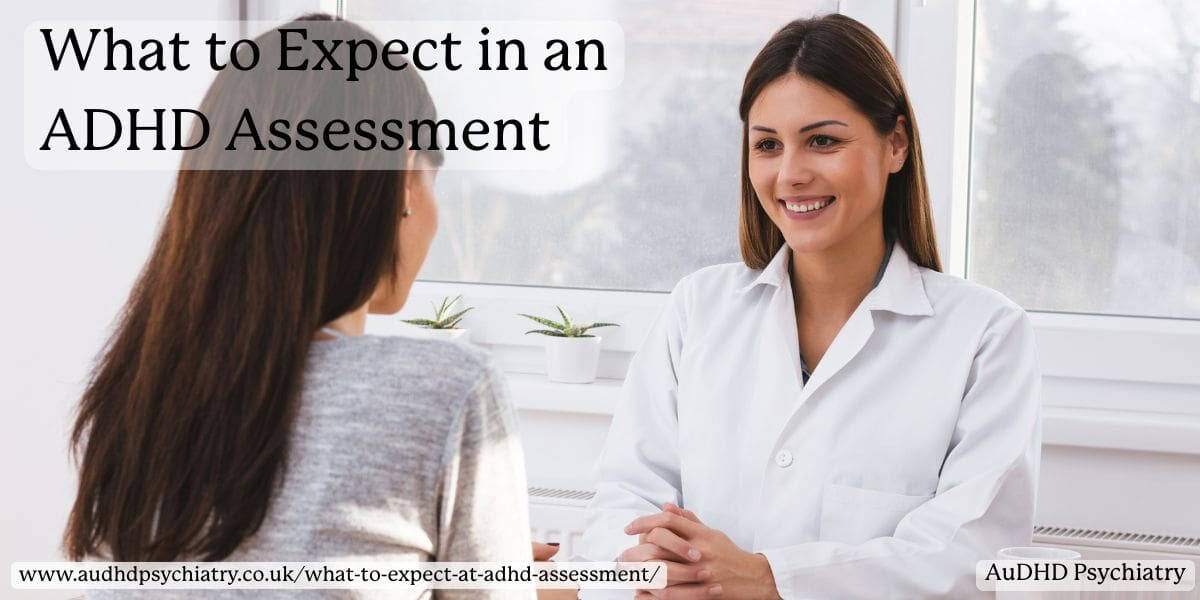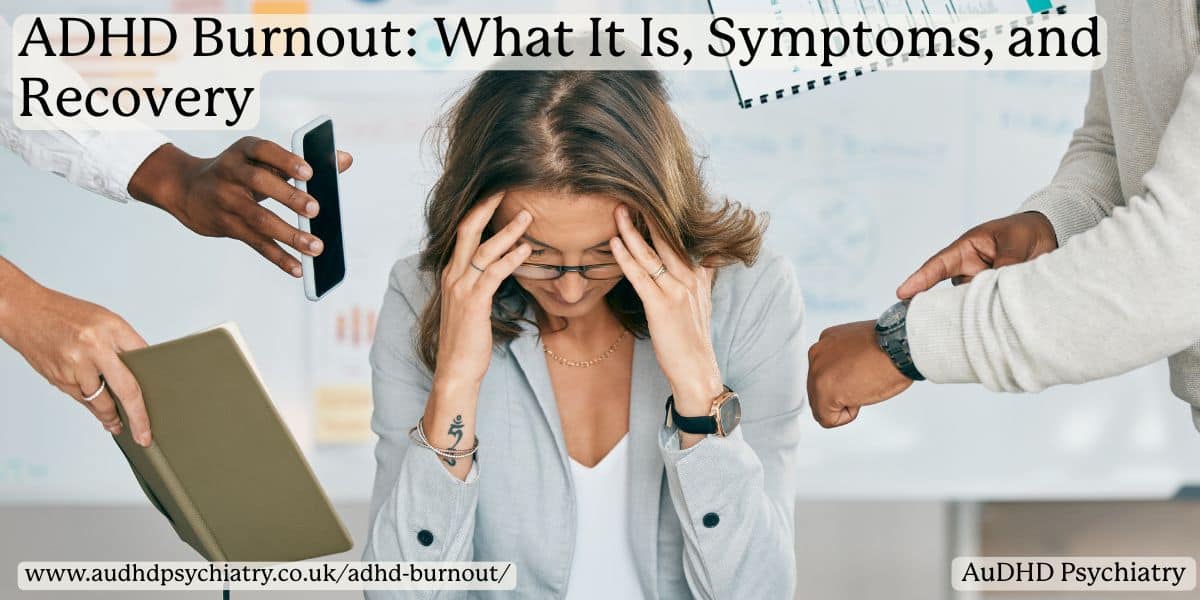
Are you feeling persistently drained, mentally foggy, or like every simple task takes longer than required? This is what many ADHDers would describe as hitting a wall—a state where focus, motivation, and energy simply seem to disappear simultaneously. This deep fatigue, which is often referred to as ADHD burnout, is very much prevalent among people living with ADHD, and while it’s a common thing, it can often be misunderstood.
Different from the usual fatigue, ADHD burnout is a result of chronic stress, executive dysfunction, and persistent efforts to deal with everyday life that is not, in fact, friendly to neurodivergent brains. In the long run, unaddressed ADHD burnout can not only hinder work but also disrupt relationships and mental health; yet with suitable methods and expert guidance, it is possible to recover from it.
If you have ever caught yourself thinking, “Do I really have ADHD, and is this the reason I’m so drained all the time?”, then it means that maybe the first step you should take is to book an ADHD assessment to find out what is actually going on beneath the exhaustion.
What Is ADHD Burnout?
ADHD burnout is such a condition that has to do with the prolonged abiding emotional fatigue, mental fatigue, and physical exhaustion when the brain’s compensating resources are depleted. It is more than ordinary tiredness. It is the collection of the stress that has been chronic for a long time and the effort needed to handle attention deficit hyperactivity disorder (ADHD) in a fast-moving, often overwhelming world.
ADHD individuals usually have to put much more effort into things like concentrating, organising their day, and fulfilling responsibilities than those who do not have ADHD. This process of constant self-monitoring costs energy like a mental “run out” that is similar to a body response after a long sprint, but it actually happens in the mind.
How Is It Different from Regular Burnout?
ADHD burnout is solely linked to the neurodevelopmental condition rather than usual burnout, which is often due to overwork or emotional strain. It is an unwanted result of the continuous effort of trying to fulfil expectations while grappling with symptoms such as executive dysfunction, time blindness, and emotional dysregulation.
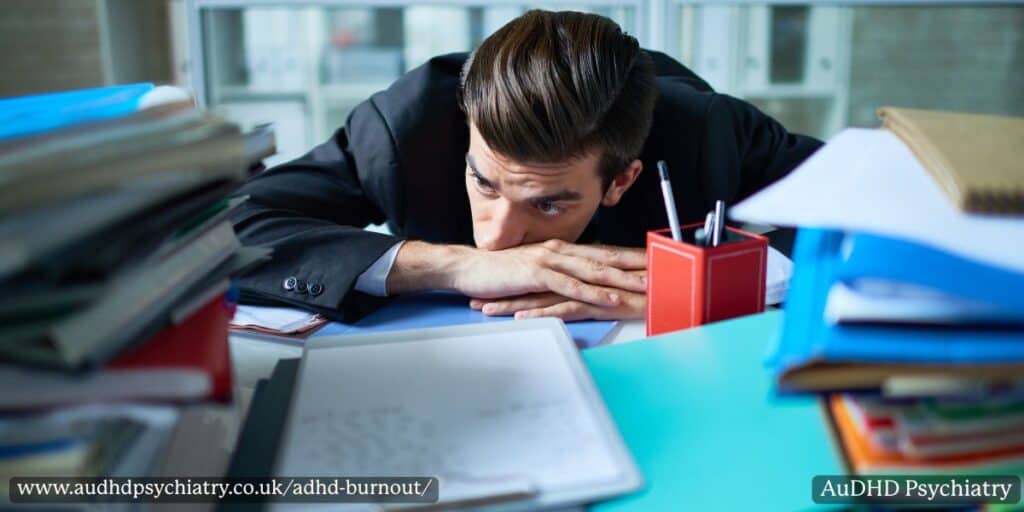
What Does ADHD Burnout Look Like?
You may experience it as a fleeting thing that comes into being after some time of really intense focus or responsibility, for instance, when you are completing a big project, taking responsibilities in the home, or trying to manage multitasking with no real time of rest. The ADHD brain can stay for long periods in “hyperfocus mode”, but it mostly results in an unavoidable crash when both motivation and dopamine levels go down.
The most important consideration here is the ability to differentiate ADHD burnout from regular burnout. In contrast to regular burnout, which is usually alleviated by vacations or rest, ADHD burnout requires a more individualised approach to treat it—an approach that would take into account cognitive fatigue, sensory overload, and the brain’s need for a constant framework.
Research has shown that students with ADHD traits experience higher levels of stress. If you’re curious, visit our guide on Common ADHD Symptoms to have a better understanding of how ADHD symptoms could be interwoven with your burnout patterns.
ADHD Burnout Symptoms
Although ADHD burnout is distinctly manifested, the most typical scenarios of ADHD burnout come from the human body, the mind, and the emotions. The attribute that sets ADHD burnout apart is its direct tie to executive dysfunction: the cognitive abilities that help regulate attention, ordering, and emotion.
In some cases of regular burnout syndrome, one might have general fatigue, while in ADHD burnout, the moods are dominated by a sense of inefficiency, and life navigation becomes difficult. The signs that are present also have a lot in common with other mental health diseases, such as anxiety problems or sleeping issues, which may complicate the identification of the condition without expert insight.
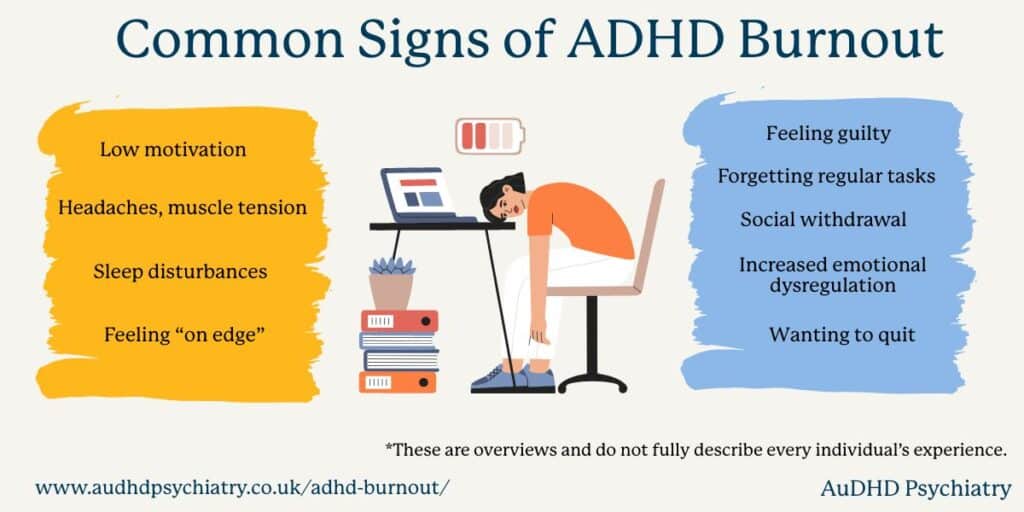
Physical Symptoms of ADHD Burnout
Many people have complained about the physical signs, which are similar to the signs of extreme exhaustion or stress. The main physical signs include:
- Consistent chronic fatigue that does not improve with rest.
- Headaches, muscle tension, and changes in heart rate linked to prolonged stress.
- Sleep disturbances, such as insomnia or unrefreshing sleep.
- Increased sensitivity to sensory overload, where noise or light feels overwhelming.
- Reduced immune function or frequent illness due to sustained chronic stress.
These physical signs emphasise the body’s difficulty in regulation, which is caused by long periods of cognitive strain—a process that is referred to as mental exhaustion.
Emotional and Mental Symptoms
On an emotional level, ADHD burnout is like a state of motivation and joy being at a lower volume. You could go through:
- Emotional dysregulation: extreme irritability, frustration, or emotional numbness.
- Feeling of poor motivation, even for activities you usually enjoy.
- Feelings of guilt, inadequacy, or failing after the extended period of effort.
- Heightened stress response and a sense of being “on edge.”
Such patterns are generally introduced by the long efforts to appear “in control” or meet the neurotypical standards as far as work, school, or in relationships—a process called masking.
Cognitive and Behavioral Symptoms
ADHD burnout also causes the impairment of executive functioning, so that completing daily chores becomes an insurmountable challenge. For example, signs may include:
- Not being able to do simple tasks like responding to emails or cleaning the room.
- Forgetting to-do lists and managing tasks.
- Inability to switch activities or focus.
- Avoidance behaviours and withdrawal from social interaction.
This level of burnout may cause the brain with ADHD to shut down temporarily, paving the way for rest even when there are tasks or duties.
The Consequences of ADHD Burnout on Daily Life
The issue of ADHD burnout is much more than just a case of tiredness from daily demands. It can have adverse effects on work, social relationships, and the ability to perform daily chores compared to the past, when it was easy to do so. It is often described by individuals as a total energy collapse—both mentally and emotionally—to the point where even small chores seem like rock climbing.
Everyday Functioning and Energy Depletion
During burnout, daily life may feel like a loop: a cycle of effort, and the ability to care for tasks like paying the bills, cleaning, or replying to messages may take hours of mental preparation. Cognitive fatigue can also lead to executive dysfunction, where motivation, planning, and follow-through all decline.
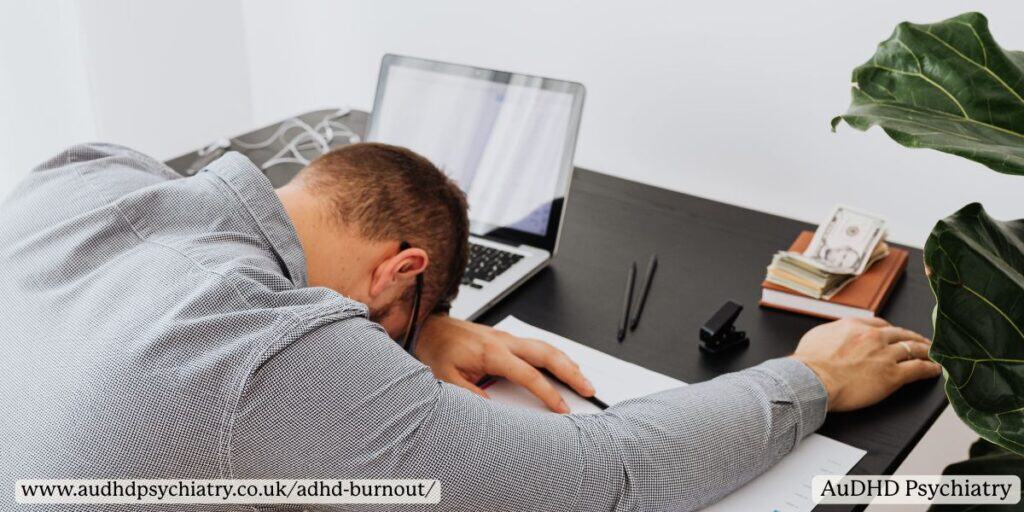
This depletion might also lead to decision paralysis, wherein even trivial choices become too burdensome. Eventually, these loops of ineptitude can beat down self-esteem, leading to frustration or self-blame, even though the problem really is the brain’s incapacity to concentrate and self-regulate long-term.
If you feel these challenges align with your own and you want to find out if your exhaustion is caused by ADHD burnout, starting with an accurate diagnosis would be helpful. Book an ADHD assessment with us – we’d be happy to help you get answers and guide you through recovery.
Relationships and Social Interactions
Burnout does not simply reduce productivity; it also has an effect on how people relate to each other. Several people with ADHD describe being withdrawn from friends or loved ones to recharge their batteries, resulting in social isolation or misunderstandings. Partners or co-workers may perceive the initiator as a lack of interest rather than burnout.
Emotional sensitivity is yet another contributing factor. The feeling of rejection or criticism takes its toll more than usual and therefore permits rejection sensitive dysphoria, which is fairly common but less discussed among adults with ADHD. This emotional strain generally worsens the symptoms of burnout, thus increasing the feelings of guilt and avoidance.
Wider Mental Health Consequences
Without taking the needed measures, ADHD burnout can quickly progress to or coexist with a number of other diseases, like depression or anxiety disorders. A sense of hopelessness, irritability, and, in severe situations, suicidal thoughts may be present, especially without the necessary professional support. Plenty of people with neurodiversity, particularly those who have AuDHD (meaning ADHDers who also have autism spectrum disorder), undergo the same cycles of physical and emotional fatigue. Such moments, referred to as autistic burnout, are sometimes confused with the effects of being autistic, even though the underlying causes are not the same.
Offices or schools that have awareness about ADHD advance the journey to recovery. Workers may distinguish staying late or not producing quality work as a sign of laziness rather than considering that the worker is battling with chronic exhaustion, which re-enacts undesirable effects on the situation, like shame and stress. Students may feel the same if they fail activities, tests, etc. Some of the strategies include scheduling flexibly, reducing sensory exposure, and redesigning everyday tasks.
Acquiring knowledge on how burnout blocks attention and performance will let you set up more appropriate coping methods. Our article on Autistic Burnout is an informative guide that tells you how this state can affect mental stamina and recovery.
ADHD Burnout Treatment and Recovery Strategies
Recovering from ADHD burnout isn’t about one-time cures. It is a protracted process of mind-body equilibrium restoration. The main purpose is to replenish energy, diminish chronic stress, and stop the cycle from repeating itself.

Best Ways to Recover from ADHD Burnout
The key principle behind the recovery process from ADHD burnout is practical self-awareness and consistent rest. Resetting both focus and emotional stability can be achieved through the following strategies:
- Regular breaks: Schedule short rest periods between tasks to avoid cognitive overload.
- Consistent routine: Create a simple structure with predictable start and finish times.
- Restful sleep: Prioritise regular sleep patterns to improve mood and focus.
- Sensory management: Decrease light brightness, background noise, and other triggers that add to sensory overload.
- Lifestyle changes: Balance caffeine, nutrition, and movement to support dopamine and blood sugar levels.
For some, the use of time-blocking apps for daily “unplugged” activities can be a powerful weapon for regaining concentration.
Professional Help and Support Networks
Recovery becomes all the more efficient when one has the guidance of professionals who know neurodiversity. Working with mental health professionals who are well-versed in ADHD will help you figure out which coping mechanisms are realistic for you, along with pinpointing your emotional triggers.
On the other hand, ADHD coaching is another form of treatment which emphasises daily management strategies. Assembling a support network through friends, online communities or joining/supporting groups is a critical step towards wellbeing. Peer-led settings bring about the reduction of shame and the normalisation of the rest requirement.
If burnout has affected your focus or relationships to a great extent, you might want to try therapy that integrates emotional regulation techniques. The structured treatment programs and early intervention are effective in preventing chronic relapse. At AuDHD Psychiatry, we provide holistic support to adults who are experiencing difficult ADHD related challenges. You can learn the ways in particular that professional help is beneficial to you through this article.
Medication and Clinical Support
For some, adjusting or reviewing ADHD medication plays a role in burnout recovery. Medications like methylphenidate or lisdexamfetamine can help restore dopamine balance and improve focus, though dosages may need reassessment during periods of high stress or fatigue.
Medication works best alongside lifestyle and environmental changes, not as a standalone solution. The combined approach of medical re-evaluation, self-care, and emotional support builds a treatment plan that not just brings relief but sustains it effectively.
The safest first step to take if you are uncertain is to consult an ADHD-aware clinician. They are the only ones formally qualified to give you advice on ADHD burnout, depression or anything else that is related, and they also require differently-managed treatment.

Preventing the ADHD Burnout Cycle
When core elements such as planning breaks and restructuring workloads are put in place, the recovery from ADHD burnout is not only faster, but it also fosters the attainment of mastery skills in areas of focus. It is also important to note that self-awareness, realistic expectations, and emotional support from others are the three pillars on which rests the prevention of ADHD burnout.
Building the Right Support and Structure
The best general recommendation we can give you is to find the right balance in creating certainty and flexibility. This is a common practice for people; for instance, structure is great to stay grounded, but with enough freedom to adapt.
Here are practical ways to reduce the risk of burnout:
- Plan breaks regularly during the day, even if you feel that the tasks are unaccomplished. These moments help reset cognitive energy before the fatigue builds up.
- Utilise digital planners or habit-stacking methods for basic task management so that the achievements are visible.
- Set the goals that you can achieve based on your energy level, not someone else’s timetable.
- Engage in personal interests that can increase your dopamine levels like art, crafts or physical activities.
- Ask for specific workplace accommodations, such as a quiet zone, flexible hours, or structured feedback, which will reduce the environmental triggers.
Building this foundation requires a lot of patience and experimentation. Certain individuals find it useful to use the stacking method for the daily routines; you get to figure it out in Habit Stacking for ADHD.
Developing Resilience Through Awareness
The first step to resilience is becoming aware of the early signs of depletion. The small signs like restlessness, forgetfulness or irritability are usually observed several weeks before the full-blown burnout. Keeping a record of these signs may grant you an opportunity to intervene early and regain the balance before reaching the critical point.
The second tool is to set boundaries. This may call for the ability to say no to commitments to protect your cognitive energy from matters that are not truly important. Checking oneself regularly, journaling, and therapy seminars might, in the long run, assist in the development of emotional regulation and awareness.
The prevention of burnout is not only about the total elimination of stress but rather the understanding of your limits and the implementation of adaptive measures before those limits are surpassed. Embracing even a measure of lifestyle changes might be a resort to chronic fatigue and make life easier for daily living. More strategies for focus and motivation can be found in ADHD Study Hacks, some of these same skills can help keep your energy up and stop the burnout cycle from happening again.
ADHD Burnout: Conclusion
ADHD burnout is a general experience often misunderstood and viewed as laziness or willpower failures. But basically, it signifies the emotional turmoil and the persistent effort put into creating a comfortable environment for the majority of the people who are neurotypical. Noticing this behavioural pattern is not a sign of failure but merely the first action towards health and long-lasting happiness.
Restoring depleted energy is made possible through self-awareness, compassion, and right support. Regular routines, ADHD-friendly environments, and getting informed can serve as stabilisers and help rebuild lost confidence. If the strategy is right, you can rekindle your energy, find motivation again, and prevent the cycle from coming back.
If you are in a state of doubt whether your exhaustion, lack of motivation, or sudden emotional ups and downs are due to ADHD, the best place to start is to consider seeking professional help. You can book a private ADHD assessment with us, and an ADHD expert clinician will guide you.
Practising the art of making time for yourself to rest, recalibrate, and ask for help can make you move beyond exhaustion and build a sustainable rhythm that supports your well-being every single day.
References
Erdal, K., Adami, G., Gelléri, P., & Dettmers, J. (2025). Stress and burnout in university students with ADHD-like symptoms: The role of memory bias and daily stress. International Journal of Educational Research Open, 9, 100497. https://doi.org/10.1016/j.ijedro.2025.100497
You Might Also Like
Contact Us
We’re here to answer any questions you might have.
Get in Touch
Opening Hours
Contact Form
We’re here to help. Reach out and we’ll get back to you within 24 hours (Monday – Friday).

